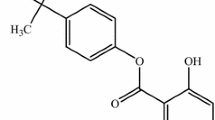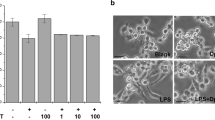Abstract
CGP 47969A is a novel inhibitor of the biosynthesis of interleukin-1 and other cytokines, being developed as an anti-arthritic. The effect of the compound on lipopolysaccharide (LPS; 1 μg/ml) stimulated nitric oxide (NO) production by the mouse macrophage cell line, J774A.1, was examined in the present study. CGP 47969A inhibited NO production in a concentration-dependent fashion (0.1–10 μM; IC50=2 μM) in a 24 h assay. Dexamethasone (Dex), which inhibits cytokine and inducible nitric oxide synthase (iNOS) gene transcription, andN-methyl arginine (NMA), a substrate analogue inhibitor of NOS activity, also inhibited NO production in this assay system with IC50 values of approximately 5 nM and 100 μM, respectively. When iNOS expression was induced by LPS for 24 h, CGP 47969A and Dex did not inhibit NO production, whereas NMA retained activity (IC50=40 μM). In time course experiments, CGP 47969A (10 μM) or Dex (1 μM) were added to J774A.1 cultures att=0, 1, 3 or 6 h after LPS. Dex inhibited NO production by 86%, 57%, 35% and 15% at these time points, while CGP 47969A inhibited by 90%, 91%, 89% and 76%. Taken together, the results indicate that CGP 47969A inhibits NO production by an effect similar to the inhibitory effect on cytokine production rather than by inhibition of iNOS enzyme activityper se or iNOS gene expression. The ability of CGP 47969A to inhibit cytokine and NO production may explain its efficacy in animal models of arthritis.
Similar content being viewed by others
References
T. Geiger, C. Rordorf, A. Cosenti-Vargas, P. G. Ferrini, L. Widler, M. Glatt and K. Vosbeck,CGP 47969A: Effect on collagen-induced arthritis in DBA/1 mice. J. Rheumatol. (1994) (in press).
C. Rordorf, R. Henn, T. Geiger, R. Solf, M. Lerch, J. Dawson, H. Nguyen, O. Zingel, H. Towbin, P. G. Ferrini and K. Vosbeck,CGP 47969A inhibits the synthesis of inflammatory cytokines. International Congress on Inflammation. Vienna, October 10–15, 1993.
C. A. Dinarello and N. Savage,Interleukin-1 and its receptor. Crit. Rev. Immunol.9, 1–20 (1989).
C. Nathan,Nitric oxide as a secretory product of mammalia cells. FASEB J6, 3051–3064 (1992).
S. Moncada and A. Higgs,The l-arginine — nitric oxide pathway. New Engl. J. Med.329, 2002–2012 (1993).
A. K. Nussler and T. R. Billiar,Inflammation, immunoregulation, and inducible nitric oxide synthase. J. Leuk. Biol.54, 171–178 (1993).
M. Di Rosa, M. Radomski, R. Carnuccio and S. Moncada,Glucocorticoids inhibit the induction of nitric oxide synthase in macrophages. Biochem. Biophys. Res. Commun.172, 1246–1252 (1990)
D. A. Geller, A. K. Nussler, M. Di Silvio, C. J. Lowenstein, R. A. Shapiro, S. C. Wang, R. L. Simmons and T. R. Billiar,Cytokines, endotoxin and glucocorticoids regulate the expression of inducible nitric oxide synthase in hepatocytes. Proc. Natl. Acad. Sci. USA90, 522–526 (1993).
Y. Vodovotz, C. Bogdan, J. Paik, Q.-W. Xie and C. Nathan,Mechanisms of suppression of macrophage nitric oxide release by transforming growth factor-β. J. Exp. Med.178, 605–613 (1993).
N. McCartney-Francis, J. B. Allen, D. E. Mizel, J. E. Albina, Xie, Q-W., C. Nathan and S. M. Wahl,Suppression of arthritis by an inhibitor of nitric oxide synthase. J. Exp. Med.178, 749–754 (1993).
A. Ialenti, S. Moncada, and M. Di Rosa,Modulation of adjuvant arthritis by endogenous nitric oxide. Br. J. Pharmacol.110, 701–706 (1993).
M. Stefanovic-Racic, J. Stadler and C. H. Evans,Nitric oxide and arthritis. Arth. Rheum.36, 1036–1044 (1993).
J. B. Weinberg, D. L. Granger, D. S. Pisetsky, M. F. Seldin, M. A. Misukonis, S. N. Mason, A. M. Pippen, P. Ruiz, E. R. Wood and G. S. Gilkeson,The role of nitric oxide in the pathogenesis of spontaneous murine autoimmune disease: Increased nitric oxide production and nitric oxide synthase expression in MRL-lpr/lpr mice, and reduction of spontaneous glomerulonephritis and arthritis by orally administered N G-monomethyl-l-arginine. J. Exp. Med.179, 651–660 (1994).
Author information
Authors and Affiliations
Rights and permissions
About this article
Cite this article
Hall, T.J., Gasser, J., Feige, U. et al. Effects of the cytokine synthesis inhibitor CGP 47969A on nitric oxide production by lipopolysaccharide-stimulated J774A.1 macrophages. Agents and Actions 43, 60–63 (1994). https://doi.org/10.1007/BF02005766
Received:
Accepted:
Issue Date:
DOI: https://doi.org/10.1007/BF02005766




